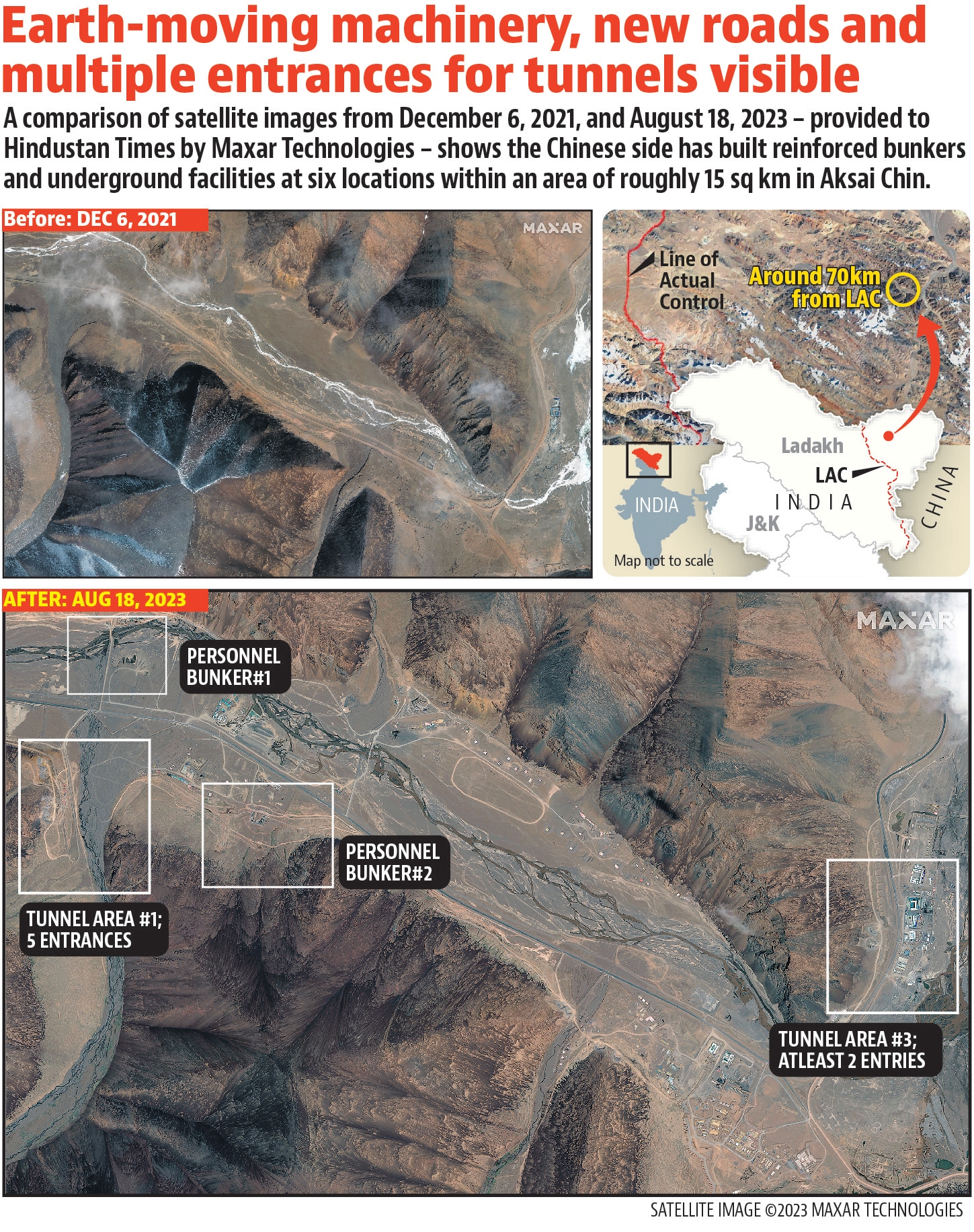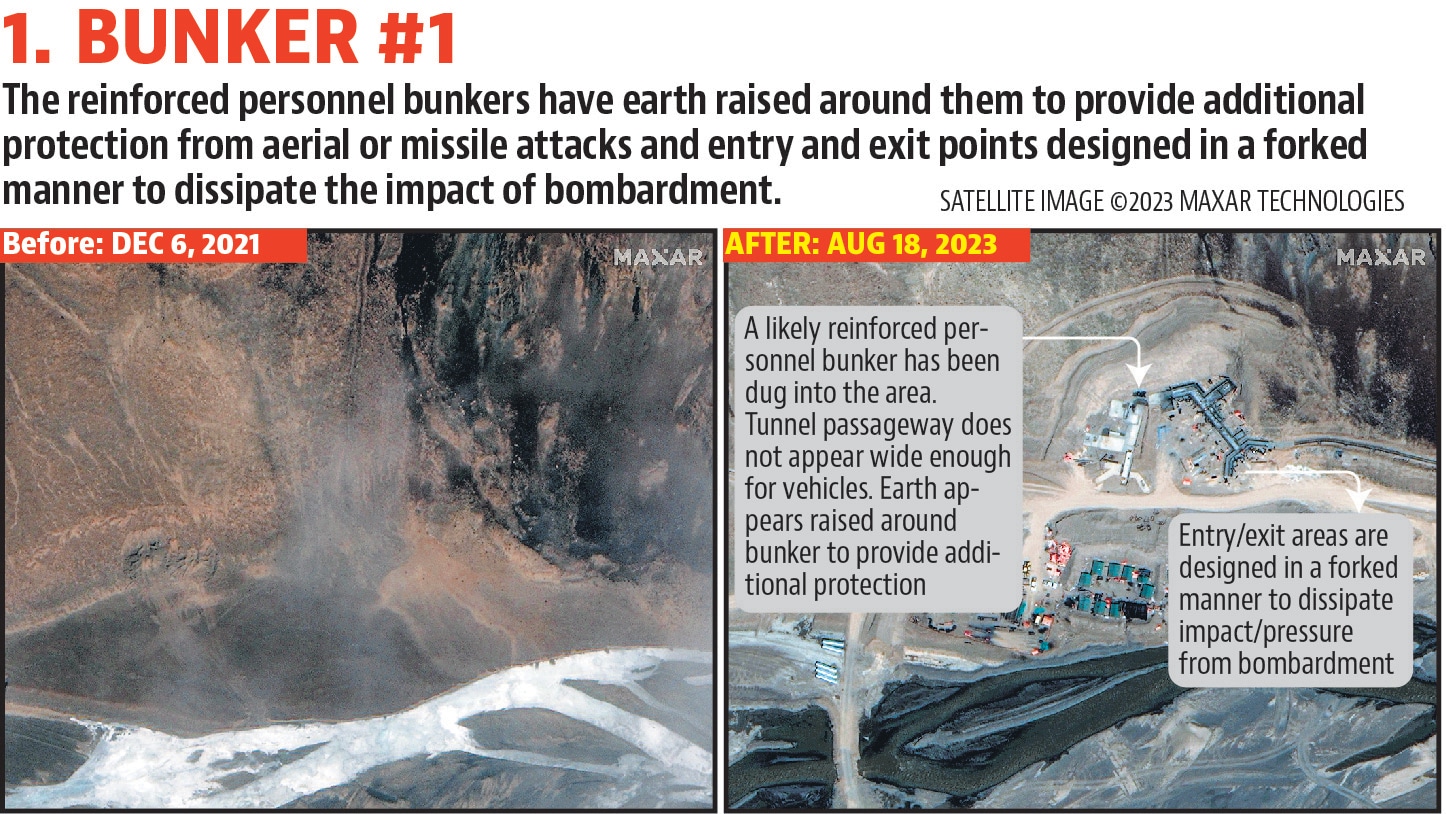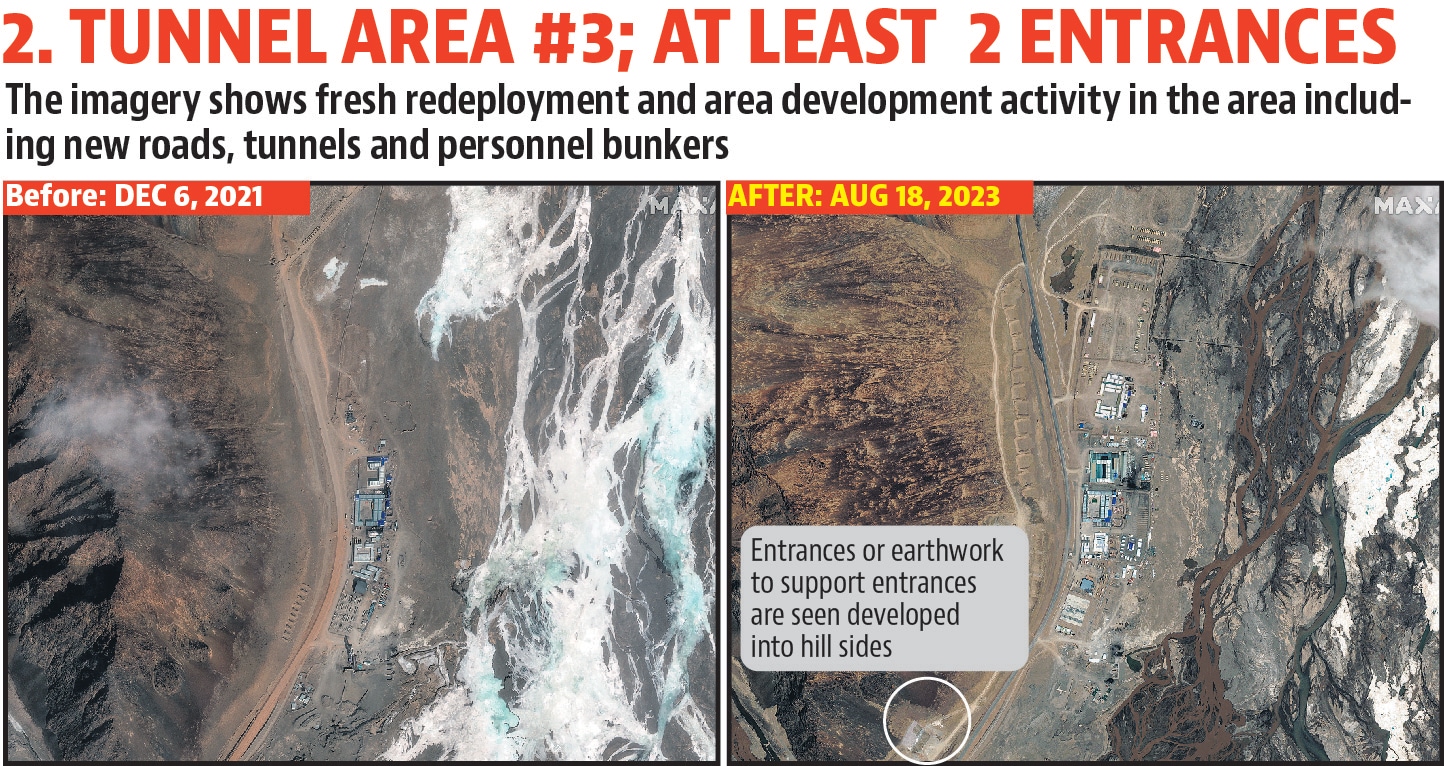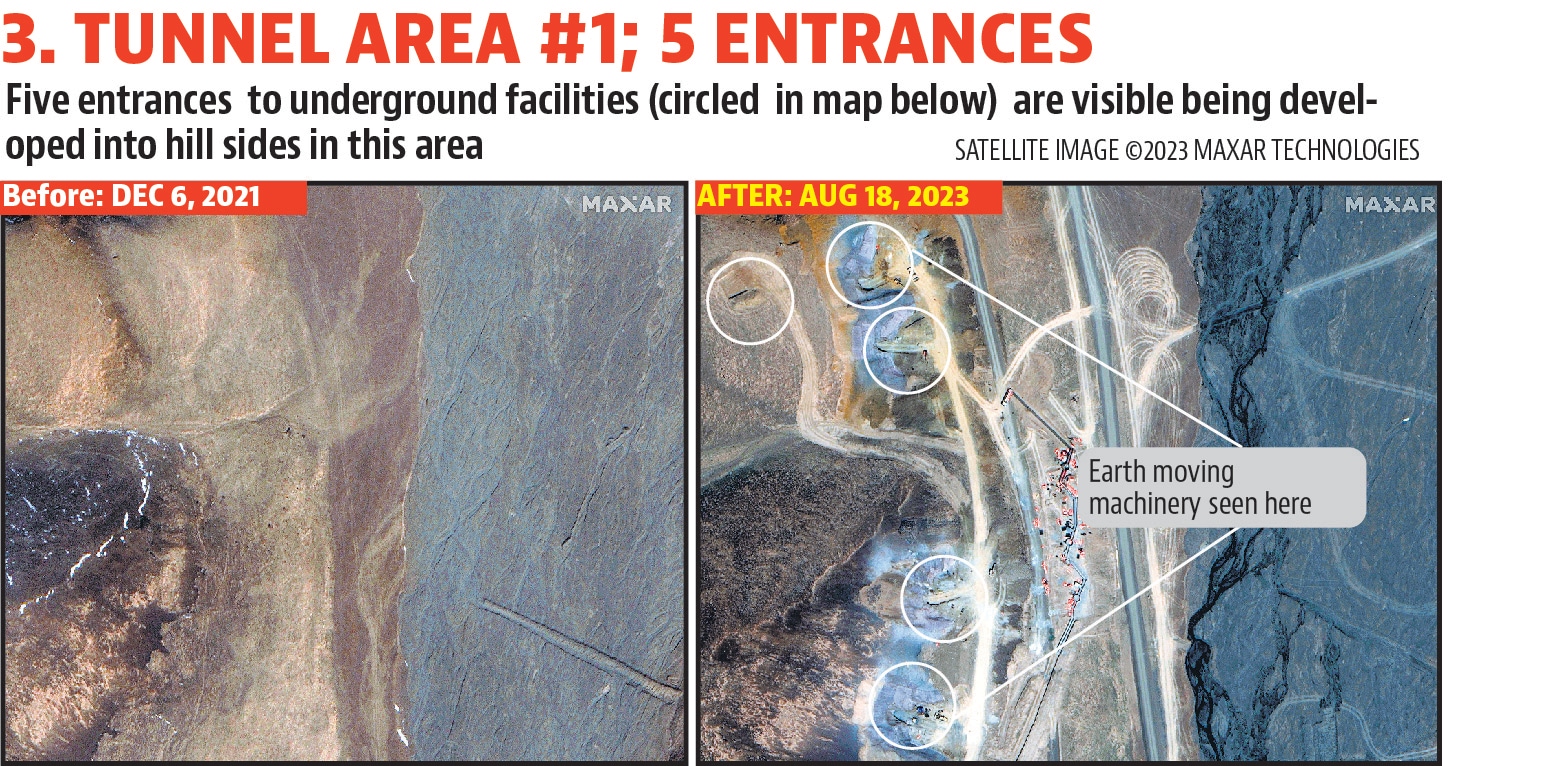China ramps up construction of tunnels, bunkers in Aksai Chin, 70km from LAC
Comparisons of satellite images from December 6, 2021 and August 18, 2023 – provided to HT by Maxar Technologies – shows reinforced personnel bunkers at 3 spots
China has ramped up the construction of reinforced personnel bunkers and underground facilities in Aksai Chin, at a location about 70km from the Line of Actual Control (LAC), to better protect its military assets from aerial or missile strikes, according to an analysis of satellite imagery.

A comparison of satellite images dating from December 6, 2021 and August 18, 2023 – provided to Hindustan Times by Maxar Technologies – shows reinforced personnel bunkers at three locations and tunnelling activity at three more locations. All six locations are within an area of roughly 15 sq km, according to the analysis.
Since the start of the military standoff on the LAC in May 2020, there has been no dearth of satellite images showing China embarking on a massive expansion of airfields, helipads, railway facilities, missile bases, roads and bridges, both for faster deployment of troops and to create a range of offensive capabilities.
However, analysts believe the construction of underground facilities and hardened bunkers, that too in an area located not very far from the LAC, is a new phenomenon aimed at protecting key assets from potential air or missile strikes.

Indian officials declined to comment on the analysis. During an informal conversation on the margins of the Brics Summit in Johannesburg last week, Prime Minister Narendra Modi told Chinese President Xi Jinping that maintaining peace and tranquillity in border areas and respecting the LAC are “essential” for normalising bilateral relations.

Using satellite imagery, HT reported in May that China has expanded crucial airbases all along the LAC by building new runways, hardened shelters to protect jets, and new support and military operations buildings. This created capabilities for its military to conduct a wider range of operations and to counter India’s comparative advantages in some areas.
The new satellite imagery from August 18 clearly depicts the evolving Chinese posture in Aksai Chin, including the development of underground facilities.
Sim Tack, geo-intelligence analyst at Force Analysis, said: “The key question raised by this activity is what will the underground facilities house? They are not for troops or tanks. They might be for high-end assets, such as air defence or missile systems, that require a higher level of protection.”

Air Vice Marshal (retired) Manmohan Bahadur, an aviator who served extensively in the Ladakh region, concurred that the underground facilities were not for troops. “Tunnels are purely for equipment that is sensitive. These underground facilities appear to be for explosives, missiles or armament that would be destroyed by an aerial weapon,” he said.
“The underground facilities could also be used for command posts, not low-level ones, but those that control substantial formations, such as a brigade or a division. They are safeguarding their leadership,” Bahadur added.
Damien Symon, geo-intelligence researcher at The Intel Lab who helped analyse the images, said: “By establishing subterranean facilities and enhancing underground infrastructure in close proximity to the LAC, Chinese strategists seem to be aiming at nullifying the existing advantage held by the Indian Air Force (IAF) and other long-range munitions of the Indian Army in Aksai Chin.”

He added, “This strategic move continues to highlight China’s intent to solidify a permanent foothold in Aksai Chin, coupled with their efforts to develop their depth areas to swiftly offer support and reinforcement to frontline troops. This shift in China’s strategic approach brings to light the evolving dynamics of the LAC, which are gradually resembling the heightened militarisation observed along the Line of Control (LoC).”
Symon said he believes India will be “compelled to respond by bolstering both its troop presence and infrastructure in kind”.
Bahadur, too, said the structures appear to be aimed at negating the threat posed by air strikes by IAF and missiles that the Indian side has positioned in the region since the start of the standoff. “They are increasing their resilience,” he said.
At one of the locations with tunnelling activity, at least five “portals” or entrances can be seen on hillsides along with earth-moving machinery. At the second site with tunnelling activity, at least four entrances can be seen on hillsides. At the third site, there are at least two portals on hillsides.

The reinforced personnel bunkers have earth raised around them to provide additional protection from aerial or missile attacks and entry and exit points designed in a forked manner to dissipate the impact of bombardment.
While these locations have seen troop deployments after the start of the standoff, the latest satellite imagery shows signs of fresh redeployments and the development of roads and other infrastructure.
Tack described the development of underground facilities and hardened bunkers as the “next big step” in China’s activities in the region. “This is something we haven’t seen so far in the Ladakh sector and appears to be aimed at ensuring greater survivability in case of a potential conflict,” he said.
“China has developed similar underground facilities at airbases and strategic sites in the mainland but not in Ladakh. While this is happening in one area in Aksai Chin, it could be the first step in a larger plan. It’s a new type of construction activity so it’s difficult to assess the speed of the work, but China usually doesn’t waste time. They do things at a very rapid pace,” he added.
Lt Gen (retired) Rakesh Sharma, former commander of the Ladakh corps that is responsible for Kargil, Siachen glacier and eastern Ladakh, said there have been reports of China building a new lateral in Aksai Chin, called G695, that is much closer to the LAC than G219.
“The terrain is barren and any overground structure can be easily picked up, and would be prone to targeting during hostilities. In an era of precision targeting, hardened and underground infrastructure will greatly improve survivability,” he said.
Over the past three years, China’s People’s Liberation Army (PLA) has been steadily creating infrastructure close to the LAC, including roads, oil pipelines, communications systems, habitat for troops, storage for equipment and ammunition, and villages. “This analysis of satellite images over nearly a year and half are indicative of reinforced bunkers for troops and tunnels for ammunition and other military wherewithal like guns and ammunition,” Sharma said.
“If nothing else, such infrastructure indicates preparations for an eventuality of hostilities. In a holistic context, such developments need expert analysis of usability and the larger pattern over the entire front to obtain a clearer picture of PLA’s intent,” Sharma added.








